News
Using A Starter For Homemade Bread
Experienced spiritual leader and taecher Sheila R. Vitale founded Living Epistles Ministries in 1988 and Christ-Centered Kabbalah in the year 2000. Having published more than 40 books, Sheila Vitale makes her teachings available for free on her web site, www.livingepistles.org. One of her former hobbies was baking homemade bread.
Many types of bread are traditionally made with a starter. A starter for bread is usually a simple mixture of flour, water and yeast. Once the simple ingredients are mixed together, the mixture is allowed to ferment and then added to bread dough, either in place of or in addition to more yeast. There are many types of starters called biga, poolish, preferment or sponge. These are all very similar and differ mostly in water conent (i.e. some are drier or wetter than others). Some starters are made only of flour and water then left to "catch" wild yeast from the air. This process is oftenused for sourdough breads.
The biggest difference between bread made with a starter and bread made with direct yeast is the time it takes. Starter breads take much longer to prepare, but the flavor and texture is far superior to the direct yeast method. Breads made with a starter will also usually keep better than breadds made just with yeast.


